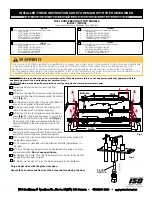
Installation and safety instructions
for AC/DC built-in devices
ebm-papst Landshut GmbH ● Hofmark-Aich-Str. 25 ● 84030 Landshut, Germany ● Phone +49 871 707-0 ● Fax +49 871 707-465 ● [email protected] ● www.ebmpapst.com
Page 3/5
1.13.
Disposal
Observe all the relevant local requirements and regulations with regard to disposal
of the device.
2.
INTENDED USE
The device is designed exclusively as a built-in device in accordance with the
technical specifications. It does not function independently and is not intended to be
handed over to end customers.
Any other usage above and beyond this does not conform to the intended purpose
and constitutes misuse of the device.
The end manufacturer is responsible for the end product and must ensure that
adequate safety precautions are taken. Customer equipment must be suited to the
mechanical, thermal and service life demands involved. All intended applications
must be checked by the end manufacturer with respect to safety.
2.1.
Intended use also includes
– The device is only to be used at the permissible ambient temperature.
– The device is only to be operated with all safety devices in position.
– The specifications must be observed.
– The built-in component is not to be started up until it has been installed in
the customer's device.
2.2.
Improper use
In particular the following types of device usage are prohibited and could lead to
hazardous situations:
General and fans:
– The conveying of a medium containing abrasive particles.
– The conveying of a medium containing substances (halogens, chlorides,
fluorides etc.) which are aggressive and/or highly corrosive.
– The conveying of a medium with a high dust content, e.g. construction ma-
terials.
General:
– Operation of the device in an environment containing explosive gases or
dusts, combustible solids or flammable liquids.
– Use of the device as a safety component or for the implementation of
safety-related functions.
– Operation in medical equipment with a life-sustaining or life-support func-
tion.
– Contact with substances which could damage device components, e.g.
cleaning fluids.
– Operation with completely or partially disassembled or manipulated safety
devices.
– Exposure to radiation which could damage device components, e.g. in-
tense UV radiation.
– Operation with external vibration.
– Operation of the device in an explosive atmosphere.
– In addition, all possible applications not listed under Intended use.
3.
CONNECTION AND START-UP
3.1.
Mechanical connection
CAUTION
Risk of cuts and crushing when removing the device from its
packaging
Lift the device out of its packaging carefully, taking care to
avoid any impact.
Wear safety shoes and cut-resistant safety gloves.
CAUTION
Unpacking the device involves lifting a heavy load
Risk of sustaining physical injury, such as back injuries.
Two people are required to lift the device out of its packaging
if it weighs more than 10 kg.
– Check the device for transportation damage. Damaged devices are not to
be installed.
– Install the device in accordance with the application concerned.
– Make use of suitable fasteners for installation.
– Protect flange surfaces, tighten screws diagonally and take care to avoid
strain on installation.
3.2.
Electrical connection
DANGER
Voltage at the device
Electric shock
A protective earth is also always to be provided for the hous-
ing/metal parts if these are not connected to a protective earth
connection (yellow/green wire) at the motor.
Check the protective earth.
DANGER
Faulty insulation
Risk of fatal injury from electric shock
Only use wiring conforming to the insulation specifications
with regard to voltage, current, insulation material and load rating
etc.
Take care to route the wiring such that it cannot come into
contact with any rotating parts.
WARNING
Voltage, electric shock
The device is a built-in component with no isolating switch.
Metallic parts may be live.
The device is only to be used together with the specified cable
protection.
Only connect the device to circuits which can be de-energised
with an all-pole disconnection switch.
When working on the device, the power must be interrupted
and the system/machine in which the device is installed must be
secured so as to prevent renewed switch-on.
WARNING
Ingress of water into wires or cables
The ingress of water at the customer end of the cable may
damage the device.
Make sure the end of the cable is connected in a dry envi-
ronment.
NOTE
Risk of subjecting devices to interference
Never route the control lines of the device right alongside the
power supply line and ignition cable (if applicable). Maintain the
greatest possible clearance.
Recommendation: Clearance > 10 cm (separate cable routing).





































